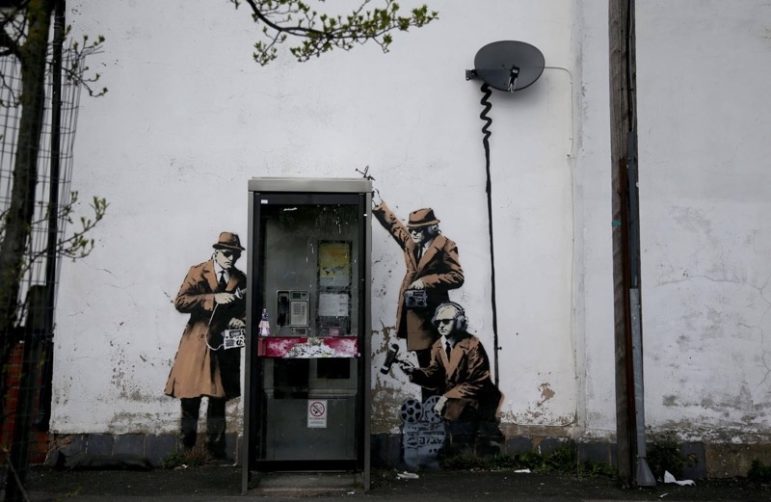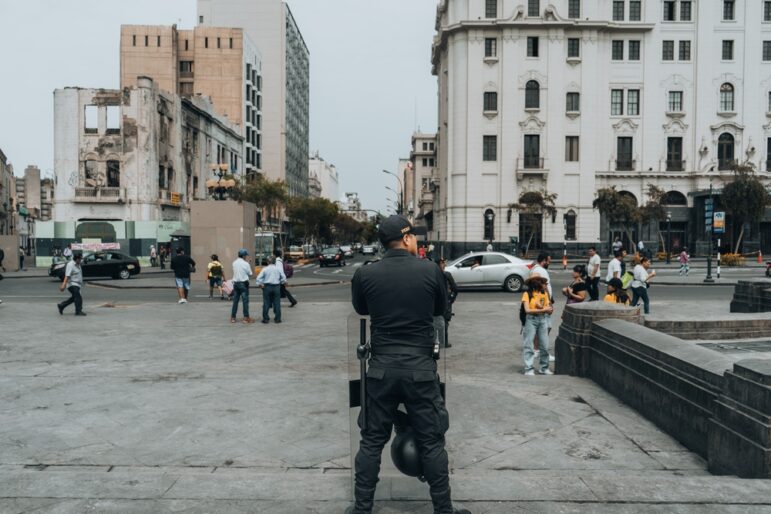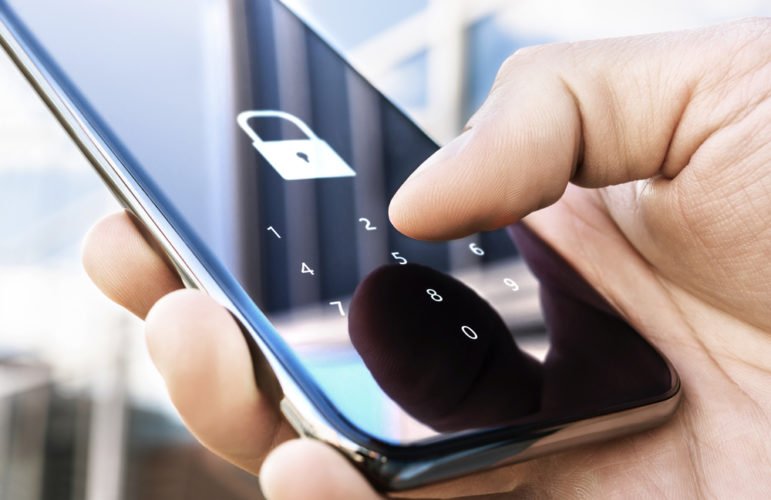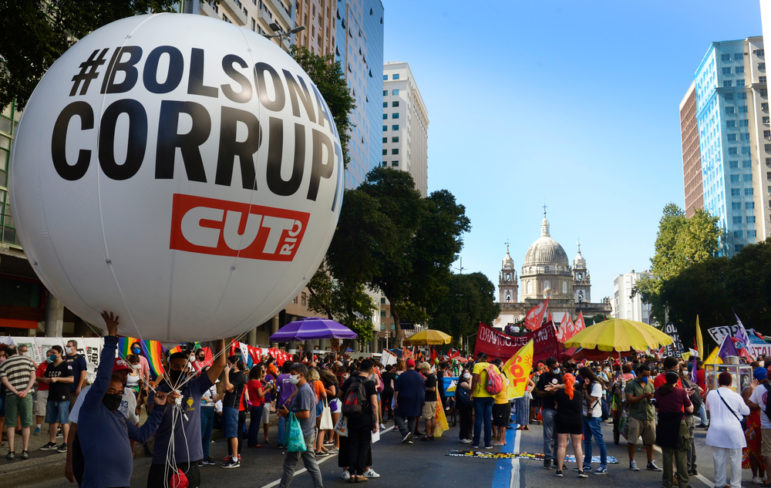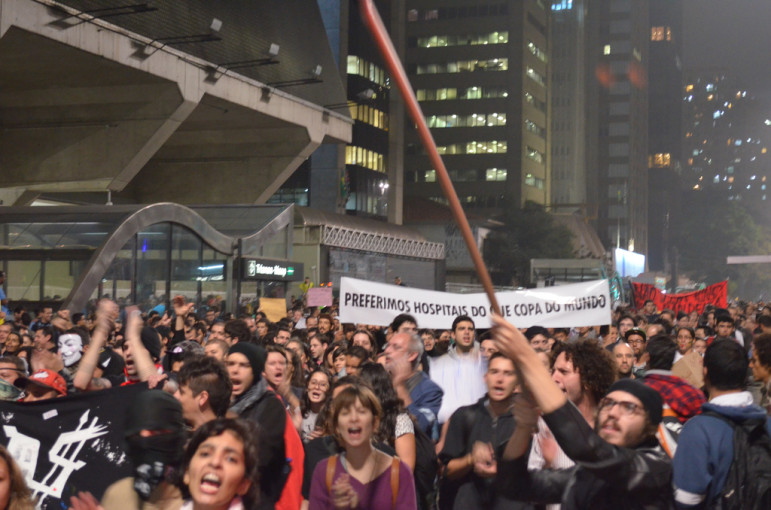

Photo: Carlos Varela in Flickr (CC License)
Abraji’s Security Manual for Covering Street Protests
 Covering street protests involves risks that every journalist should be prepared for. Knowledge, experience, and planning can help reduce these risks. Our colleagues at Abraji (The Brazilian Association of Investigative Journalism) have particular experience with this — between May 2013 and May 2014, there were at least 171 cases of violations against media staff covering street protests in Brazil.
Covering street protests involves risks that every journalist should be prepared for. Knowledge, experience, and planning can help reduce these risks. Our colleagues at Abraji (The Brazilian Association of Investigative Journalism) have particular experience with this — between May 2013 and May 2014, there were at least 171 cases of violations against media staff covering street protests in Brazil.
To help journalists worldwide, Abraji has developed a guide, packed with tips and anecdotes from pros who have experienced risky incidents while covering protests. Here’s an excerpt, which Abraji has kindly granted GIJN permission to publish. You can access the full manual in English here, in Portuguese here, and in Spanish here.
Before Leaving – Risk Analysis
– Plan your coverage ahead of time. Is there a safer way to get the information or images necessary? Plan what you will do if you are assaulted, detained or robbed. If you know the protest route, anticipate your escape routes and set them up in advance with your team members.
– Know the social and political context that is motivating the participants: what recent facts preceded the protest, what the general attitude toward media outlets is, what they think about the field you work in; do you have any characteristics that could generate additional risks (such as being a woman in a context that involves the risk of sexual violence); are there groups with a history of violence against journalists?
– Before leaving for the site, take a look, via GPS or the internet, at the terrain where the protest will take place, identifying police stations, places where you can take shelter, escape routes, which way the roads run, elevated locations for good images, dead-end streets, road-blocks, hospitals and reference points for reorganization in case you get separated from your team.
– Calculate how long you and your team will need to be on location in order to get what you need.
– Get the weather report for the coverage period. If necessary, take a waterproof jacket. In some locations, the temperature drops at night. Be prepared. Condoms can be used to keep camera memory cards dry in case there is a torrential downpour or the police use water cannons.
– Keep a constant line of communication open with the newsroom. Set up periodic intervals for sending pre-determined, and if necessary, coded text messages, such as “flat tire” equals “we’ve been detained.” Dozens of messages can be created for all manner of hypothetical situations brought up during the planning phase, put together in a table with a copy in the newsroom.
– Record more than one direct-dial number on your phone for emergencies. Insert the letter “A” at the beginning of these contacts, so that they appear at the top of your contact list. Take a back-up cell phone battery. Reduce the screen brightness and disable unnecessary apps that use up energy. Opt for phones that take two chips. Use chips from two different phone carriers.
– A reporter or assistant should help photojournalists and camera operators, as they will be focused on their job of collecting images. One of the team should maintain a broad view of the entire scene at all times, and be concerned with the team’s safety. Set up these roles in advance.
– If you have a driver, check that he is familiar with the locale, is able to plan escape routes, is always in communication and doesn’t leave the car trapped in inaccessible parking spots.
– If you have asthma, respiratory problems or infections, are pregnant, have lowered immunity, an eye infection, or use contact lenses and don’t have glasses, avoid engaging in coverage of this type. Make sure that you are physically capable of performing the task: Can you run?
– Check that, in case something happens to you, you and your family will have medical and insurance coverage.
– Use identification visible from a distance if you believe this will provide you greater protection. Hide your ID and try to blend in with the people around you if this seems more appropriate. Know how to read the context and mood of the protest participants in regard to the press. Set these procedures up with your team in advance.
– Divide your money into smaller quantities and keep it in different waterproof places on your person or in an additional wallet.
VEHICLES
– Review the condition of your vehicle: always check, before departing, that you have a valid fire extinguisher, and most importantly, that you know how to access and utilize it.
– Drivers must remain alert at all times. Hostile protesters have targeted press vehicles. Take into consideration the rules of your agency and discuss with your team whether it is better for the driver to remain outside the vehicle, within view of it or inside it with the key in the ignition, ready to leave quickly if necessary.
– After parking, the driver should remain attentive and vigilant to changes in the mood of the group and to changes in the security conditions around him. If necessary, he may consider changing the position of the vehicle, to avoid being surrounded, and should certify that the news team is informed of his new position.
– An extra key to the car should be provided and remain in the possession of another member of the team, other than the driver, who is also able to drive.
– Performing more than one function, such as driver/cameraman, increases risks for the professionals.
BASIC BACKPACK KIT
– Always use a lightweight backpack, which is easy to open and close and that fits snugly against the body, facilitating its access and movement.
– Take potable water and energy snacks in case the coverage is extended. Divide the food into small portions. You may need to handle it while walking over long periods of time.
– Know how to utilize the flashlight function of your cell phone. If you don’t have this function, download the app or carry a small flashlight with you.
– If you are unfamiliar with the local, a map may be helpful. GPS – whether for the car or cell phone, can be useful as well. Know how to operate it, test it beforehand and familiarize yourself with its functions. You can also mark your map with points of interest, such as elevated areas for capturing images, hospitals, police stations, and escape routes in advance.
– TV crews should opt for lightweight equipment, which can be carried easily. Be prepared to leave it behind if you need to get away quickly.
– Use a wristband or a medical alert badge that shows your blood type or any special medical conditions or allergies.
During the Protest
POSITIONING AND ACTION
The Committee to Protect Journalists suggests that journalists be thought of as referees on a playing field: “They should be close enough to observe the game with precision, but even so should take every precaution to avoid getting mixed up in the action.” Avoid getting surrounded by or trapped between confronting groups, or in the middle of the multitudes of people. Try to remain where it is possible to have the broadest view of the scene. Have an escape route in mind at all times. When arriving at the scene, before anything else, figure out how to get away in an emergency.
– When arriving at the local, make a mental map, identifying the position of the Riot Police and the Cavalry. These special groups may be situated one or more blocks away, out of the protesters’ view. It is important to anticipate where they might come from and in what direction to run in case they issue an order to disperse.
– Be aware of changes in the protesters’ mood and changes in the police’s position. Know how to interpret the contextual signs and anticipate the risks. Normally, a Riot Police formation indicates their intention to disperse the group. Look ahead to the direction that this movement is likely to take and plan accordingly.
– Avoid wandering through the crowd; opt for specific movements focused on recording what is necessary.
– Consider filming from a more distant vantage point, from the sidelines or from above. This planning can be done with a map, with the aid of aerial images or from information obtained from local contacts.
– Never pick up anything thrown during the protest. It could be a homemade explosive or other combustible device, as well as generate suspicion from the police that you are a protester; be wary of any and all abandoned materials.
– Don’t touch the shrapnel from grenades launched by the police. It could be hot.
– Don’t take sides with any of the groups involved.
– When filming police advances, avoid being surrounded from behind by the police involved in the situation. Stay on the sidelines. Never touch a police officer with a weapon drawn– this is especially important for photographers, who are used to asking for space to get a better angle. Remember that the individuals involved in the situation may be tense and therefore react unexpectedly to anything they consider a threat.
– Photojournalists and camera operators should take telephoto lenses with them, which allows for a closer view of the action without unnecessary exposure to risk.
– Try to avoid taking many photos of, or filming for lengthy periods of time, a single person or small group. This could give the impression that this person or group is being threatened.
– If you decide to change direction, ask for tips and advice from people who are arriving on the scene from the direction you plan to go in.
IN CASE OF AGGRESSION OR DETENTION
– If a personal object is taken from you, including video recordings or notations, demonstrate your disapproval. State that this is an act of censorship, which is prohibited by the Constitution, but don’t get involved in heated discussions, nor touch anyone.
– Depending on the situation, it may not advisable to say anything at the time. Don’t confront people angrily and respect each individual’s physical space. Observe body language. People who gesticulate a lot need more space around them. The same is true for those carrying weapons. Tolerate insults and be patient.
– Maintain visual contact when being questioned. If you are wearing dark glasses, remove them. Look in the eyes of your questioner, breath deeply and try to maintain a calm and measured rhythm to your speech. Avoid making accusations or speeding up the rhythm of the discussion. Show that you do not present a threat.
– If you are arrested, make every effort to maintain professional conduct while explaining that you are a reporter and that your work is to keep the population informed; if, even so, you are held in custody, follow directions and wait for an opportunity to present your case calmly to a superior officer.
– Recording your conversations could be helpful at this time. Small recorders or smartphone apps can be utilized cautiously and serve as evidence in your favor in the future.
– Always speak the truth and avoid changing your story. Stay calm and assume a subservient posture. Remember, your only objective at this time is to survive and get out of the situation unharmed.
– If you are the victim of an illegal arrest by a law enforcement officer, inform the prosecutor or municipal authorities and entities of the press immediately and demand the presence of a lawyer.
– If you are assaulted or abused, take note of the ID number or name of the aggressor and report him to the authorities (politician, public prosecutor, attorney) press agencies and aggressor’s superiors.
– If you are placed in a police vehicle, shout your name and the name of your media agency so that information about your arrest will begin to circulate.
Excerpted from Security Manual for Protest Coverage in Brazil, by Abraji (The Brazilian Association of Investigative Journalism), 2014.



